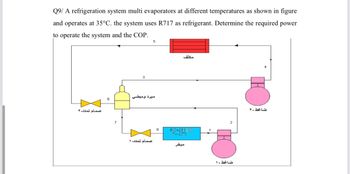
Elements Of Electromagnetics
7th Edition
ISBN: 9780190698614
Author: Sadiku, Matthew N. O.
Publisher: Oxford University Press
expand_more
expand_more
format_list_bulleted
Question
A refrigeration system multi evaporators at different temperatures as shown in figure and operates at 35C. the system uses R717 as refrigerant. Determine the required power to operate the system and the COP.

Transcribed Image Text:Q9/ A refrigeration system multi evaporators at different temperatures as shown in figure
and operates at 35°C. the system uses R717 as refrigerant. Determine the required power
to operate the system and the COP.
صمام تمدد. ۲
6
5
مبرد وميضي
صمام تمدد. ۱
مكثف
FE=250
ضاغط -1
ضاغط -۲
Expert Solution
This question has been solved!
Explore an expertly crafted, step-by-step solution for a thorough understanding of key concepts.
This is a popular solution
Trending nowThis is a popular solution!
Step by stepSolved in 3 steps with 1 images

Knowledge Booster
Learn more about
Need a deep-dive on the concept behind this application? Look no further. Learn more about this topic, mechanical-engineering and related others by exploring similar questions and additional content below.Similar questions
- A refrigeration system with a capacity of 15 tons of refrigeration, operates at 150 kPa in the evaporator, while in the condenser it is 1590 kPa. If refrigerant R-717 is saturated, calculate the theoretical power required to operate the compressor. Compressor Power = kW.arrow_forwardA refrigeration system with a capacity of 10 tons of refrigeration, operates at 210 kPa in the evaporator, while in the condenser it is 1240 kPa. If refrigerant R-717 is saturated, calculate the theoretical power required to operate the compressor. Compressor Power = AnswerkW.arrow_forwardFor a 10 ton capacity refrigeration system, the pressure of refrigerant in the evaporator is 210 kPa, whereas in the condensor it is 900 kPa. If refrigerant R-134a is used under saturated conditions, calculate the theoritical power required to operate the compressor (kW)arrow_forward
- A refrigeration unit utilises ammonia as the refrigerant. The diagram for the circuit isshown in Figure Q3 below, with the following conditions: point (1) is a saturated liquidat –30 oC, points (3), (4) and (7) is a saturated liquid at 10 oC and point (5) is a saturatedvapour at –30 oC. The isentropic efficiency of the compressor and pump is 80% and itis assumed there are negligible heat losses to the surroundings. The liquid ammoniahas a specific volume of 0.0015 m3 kg-1. (a) Discuss which factors must be considered when selecting an appropriate refrigerant?(b) Calculate the coefficient of performance (COP) of the cycle.(c) If the effect of refrigeration is 10 kW, determine the required mass flow rate.arrow_forwardThe food storage room requires a cooling system with a capacity of 10 tons of refrigeration that operates at an evaporator temperature of -17.8 ° C and a condenser temperature of 30.1 ° C. The refrigerant used is R-717 and the system operates in saturated conditions. Determine C.O.P , Refrigerant flow rate , Heat loss rate in condensesarrow_forwardI think its Chemisty... If an evaporator outlet temperature on an R-410A system is 50f and the evaporator superheat is 10f, what is the evaporating pressure of the refrigerant in the system?arrow_forward
- A refrigeration system with a capacity of 15 tons of refrigeration, operates at 150 kPa in the evaporator, while in the condenser it is 1000 kPa. If R-134a refrigerant is in a saturated state, calculate the theoretical power required to operate the compressor. Compressor Powerarrow_forward3. The system in Problem 2 assumes the AT for heat transfer between the refrigeration system condenser and the environment is zero, and the AT between the refrigeration system evaporator and the cold space is zero. This gives us the best possible performance, but it is unrealistic as you need some reasonable AT to drive the heat transfer. Assume you have a Carnot refrigerator that provides the same 10.55 kW of cooling, but the condenser operates at 35°C and the evaporator is at -15°C. These then, respectively, push heat to the environment at 20°C and pull heat out of the 0°C cold space, as shown in the figure. Assuming the cycle itself (i.e., inside the dashed line) still operates as a Carnot refrigerator, find the electric power needed to generate the 3-tons of cooling capacity, the daily cost for this electricity, and COPR. Environment=20°C QH QH Q₁ Q₁ Cold Space=0°C 35°C W -15°Carrow_forwardA refrigeration system with a capacity of 15 tons of refrigeration, operates at 150 kPa in the evaporator, while in the condenser it is 1450 kPa. If refrigerant R-717 is saturated, calculate the theoretical power required to operate the compressor. Compressor Power =arrow_forward
arrow_back_ios
arrow_forward_ios
Recommended textbooks for you
 Elements Of ElectromagneticsMechanical EngineeringISBN:9780190698614Author:Sadiku, Matthew N. O.Publisher:Oxford University Press
Elements Of ElectromagneticsMechanical EngineeringISBN:9780190698614Author:Sadiku, Matthew N. O.Publisher:Oxford University Press Mechanics of Materials (10th Edition)Mechanical EngineeringISBN:9780134319650Author:Russell C. HibbelerPublisher:PEARSON
Mechanics of Materials (10th Edition)Mechanical EngineeringISBN:9780134319650Author:Russell C. HibbelerPublisher:PEARSON Thermodynamics: An Engineering ApproachMechanical EngineeringISBN:9781259822674Author:Yunus A. Cengel Dr., Michael A. BolesPublisher:McGraw-Hill Education
Thermodynamics: An Engineering ApproachMechanical EngineeringISBN:9781259822674Author:Yunus A. Cengel Dr., Michael A. BolesPublisher:McGraw-Hill Education Control Systems EngineeringMechanical EngineeringISBN:9781118170519Author:Norman S. NisePublisher:WILEY
Control Systems EngineeringMechanical EngineeringISBN:9781118170519Author:Norman S. NisePublisher:WILEY Mechanics of Materials (MindTap Course List)Mechanical EngineeringISBN:9781337093347Author:Barry J. Goodno, James M. GerePublisher:Cengage Learning
Mechanics of Materials (MindTap Course List)Mechanical EngineeringISBN:9781337093347Author:Barry J. Goodno, James M. GerePublisher:Cengage Learning Engineering Mechanics: StaticsMechanical EngineeringISBN:9781118807330Author:James L. Meriam, L. G. Kraige, J. N. BoltonPublisher:WILEY
Engineering Mechanics: StaticsMechanical EngineeringISBN:9781118807330Author:James L. Meriam, L. G. Kraige, J. N. BoltonPublisher:WILEY

Elements Of Electromagnetics
Mechanical Engineering
ISBN:9780190698614
Author:Sadiku, Matthew N. O.
Publisher:Oxford University Press

Mechanics of Materials (10th Edition)
Mechanical Engineering
ISBN:9780134319650
Author:Russell C. Hibbeler
Publisher:PEARSON

Thermodynamics: An Engineering Approach
Mechanical Engineering
ISBN:9781259822674
Author:Yunus A. Cengel Dr., Michael A. Boles
Publisher:McGraw-Hill Education

Control Systems Engineering
Mechanical Engineering
ISBN:9781118170519
Author:Norman S. Nise
Publisher:WILEY

Mechanics of Materials (MindTap Course List)
Mechanical Engineering
ISBN:9781337093347
Author:Barry J. Goodno, James M. Gere
Publisher:Cengage Learning

Engineering Mechanics: Statics
Mechanical Engineering
ISBN:9781118807330
Author:James L. Meriam, L. G. Kraige, J. N. Bolton
Publisher:WILEY